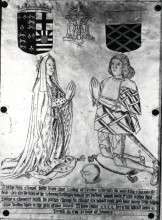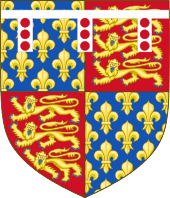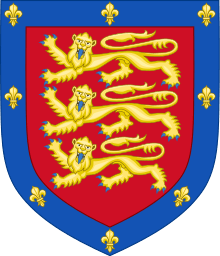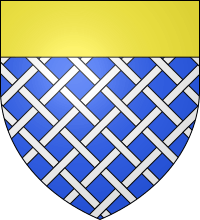Anne of York, Duchess of Exeter
Anne of York, Duchess of Exeter, aka Anne Plantagenet (10 August 1439 – 14 January 1476), was the first child of Richard Plantagenet, 3rd Duke of York, and Cecily Neville. She was thus the eldest sister of kings Edward IV (1461–1483) and Richard III (1483–1485); and of Edmund, Earl of Rutland, Elizabeth of York, Duchess of Suffolk, Margaret, Duchess of Burgundy and of George Plantagenet, 1st Duke of Clarence.
| Anne Plantagenet | |
|---|---|
| Duchess of Exeter | |
 Anne with her second husband Thomas St Leger. Monumental brass in "St Leger Chantry" (later "Rutland Chantry"), St George's Chapel, Windsor Castle | |
| Born | 10 August 1439 Fotheringhay, Northamptonshire, England |
| Died | 14 January 1476 (aged 36) |
| Burial | 1 February 1476 St Leger Chantry, St. George's Chapel, Windsor |
| Spouse | Henry Holland, 3rd Duke of Exeter Thomas St. Leger |
| Issue | Lady Anne Holland Anne St. Leger, Baroness de Ros |
| House | York |
| Father | Richard Plantagenet, 3rd Duke of York |
| Mother | Cecily Neville |
| Religion | Roman Catholicism |
| English Royalty |
| House of York |
|---|
 Armorial of Plantagenet |
| Richard Plantagenet, 3rd Duke |
Marriages and issue
Anne married twice and divorced her first husband:
First marriage

In 1447 aged eight years old, Anne was married to Henry Holland, 3rd Duke of Exeter (1430–1475). During the Wars of the Roses Exeter sided with the House of Lancaster against his wife's family the House of York. Exeter was a commander at the great Lancastrian victories at the Battle of Wakefield and Second Battle of St Albans. He was also a commander at the Lancastrian defeat at the Battle of Towton. He fled to the Kingdom of Scotland after the battle, and then joined Margaret of Anjou in her exile in France, queen consort of the Lancastrian King Henry VI. On 4 March 1461 Anne's younger brother Edward, Duke of York, was declared in London as King Edward IV. Exeter was attainted but the new king gave his estates to Anne, with remainder to their daughter Anne Holland. Anne and Exeter separated in 1464 and divorced in 1472. During the Readeption of Henry VI, Anne remained loyal to her brother Edward, and, in what seems to have been her only intervention in politics, worked hard to persuade her brother George, Duke of Clarence, to abandon the Lancastrian cause. If not decisive, her arguments certainly had some effect and thus she played some part in Edward's restoration.
By the Duke of Exeter Anne had one daughter, Anne Holland (1461[1] – between 26 August 1467 and 6 June 1474), who was married in October 1466[2] at Greenwich Palace to Thomas Grey, 1st Marquess of Dorset, son of Edward IV's queen Elizabeth Woodville by her first husband. Lady Dorset died sometime between 26 August 1467 and 6 June 1474 without children. Grey subsequently married Cecily Bonville, 7th Baroness Harington, another rich young heiress, by whom he had issue.[3]
Second marriage

Anne married secondly in about 1474 to Thomas St. Leger (c. 1440 – 1483), a loyal follower of his brother-in-law King Edward IV (1461–1483). He took part in the Duke of Buckingham's attempted rebellion against King Edward's younger brother and eventual successor King Richard III (1483–1485), on the failure of which he was executed in 1483. King Edward IV had however in 1467 extended the remainder of most of the former Duke of Exeter's lands to the King's sister, Anne, and to any heirs of her body. Thus, if she remarried any future children could inherit them.
Anne died giving birth to her only daughter by Thomas, Anne St. Leger (14 January 1476 – 21 April 1526), who due to the special remainder was heiress to the estates of her mother's first husband Henry Holland.[5] She married George Manners, 11th Baron de Ros, and was mother of the royal favourite Thomas Manners, 1st Earl of Rutland.
Death and burial
Anne died and was buried on 1 February 1476 in the St Leger Chantry, forming the northern transept of St. George's Chapel, Windsor Castle, founded in 1481 by her husband,[6] "with two priests singing forevermore". It was later named the Rutland Chantry in honour of her son-in-law George Manners, 11th Baron de Ros (whose effigy, with that of his wife Anne St Leger, is situated in the chantry), father of Thomas Manners, 1st Earl of Rutland. A Monumental brass in memory of Anne of York and her husband Sir Thomas St Leger survives on the east wall of the St Leger Chantry inscribed as follows:
"Wythin thys Chappell lyethe beryed Anne Duchess of Exetur suster unto the noble kyng Edward the forte. And also the body of syr Thomas Sellynger knyght her husband which hathe funde within thys College a Chauntre with too prestys sy’gyng for ev’more. On whose soule god have mercy. The wych Anne duchess dyed in the yere of oure lorde M Thowsande CCCCl xxv"
The arms above Anne show her paternal arms of the Dukes of York: in the dexter half the royal arms of England, emphasising their descent from Lionel of Antwerp, 1st Duke of Clarence (1338–1368), third son of King Edward III (on which basis the House of York claimed the throne), who married Elizabeth de Burgh, 4th Countess of Ulster (1332–1363). Their daughter Philippa de Burgh married Edmund Mortimer, 3rd Earl of March, whose son Roger de Mortimer, 4th Earl of March, was the great-grandfather of Anne, her brother King Edward IV, and their siblings; In the sinister half are shown in chief: Or a cross gules (de Burgh) and in base: Barry or and azure, on a chief of the first two pallets between two base esquires of the second over all an inescutcheon argent (Mortimer).
Ancestors
| Ancestors of Anne of York, Duchess of Exeter | |||||||||||||||||||||||||||||||||||||||||||||||||||||||||||||||||||||||||||||||||||||||||||||||||||||||||||||||||||||||||||||||||||||||||||||||||||||||||||||||||||||||||||||||||||||||||||||||||||||||||||||||||||||||||||||||||||||||||||||||||||||||||||||||||||||||||||||||||||||||||
|---|---|---|---|---|---|---|---|---|---|---|---|---|---|---|---|---|---|---|---|---|---|---|---|---|---|---|---|---|---|---|---|---|---|---|---|---|---|---|---|---|---|---|---|---|---|---|---|---|---|---|---|---|---|---|---|---|---|---|---|---|---|---|---|---|---|---|---|---|---|---|---|---|---|---|---|---|---|---|---|---|---|---|---|---|---|---|---|---|---|---|---|---|---|---|---|---|---|---|---|---|---|---|---|---|---|---|---|---|---|---|---|---|---|---|---|---|---|---|---|---|---|---|---|---|---|---|---|---|---|---|---|---|---|---|---|---|---|---|---|---|---|---|---|---|---|---|---|---|---|---|---|---|---|---|---|---|---|---|---|---|---|---|---|---|---|---|---|---|---|---|---|---|---|---|---|---|---|---|---|---|---|---|---|---|---|---|---|---|---|---|---|---|---|---|---|---|---|---|---|---|---|---|---|---|---|---|---|---|---|---|---|---|---|---|---|---|---|---|---|---|---|---|---|---|---|---|---|---|---|---|---|---|---|---|---|---|---|---|---|---|---|---|---|---|---|---|---|---|---|---|---|---|---|---|---|---|---|---|---|---|---|---|---|---|---|---|---|---|---|---|---|---|---|---|---|---|---|---|---|---|---|
| |||||||||||||||||||||||||||||||||||||||||||||||||||||||||||||||||||||||||||||||||||||||||||||||||||||||||||||||||||||||||||||||||||||||||||||||||||||||||||||||||||||||||||||||||||||||||||||||||||||||||||||||||||||||||||||||||||||||||||||||||||||||||||||||||||||||||||||||||||||||||
Notes
- Oxford, Bodleian Library MS Digby 57, f. 2*r
- Cawley 2011, Earls of Kent.
- Ross, Charles Derek (1974). Edward IV. Berkeley and Los Angeles: University of California Press. p.336
- Debrett's Peerage, 1968, p.365, St Leger, Earl of Doneraile
- Ross 1997, pp. 336-337.
- http://www.stgeorges-windsor.org/archives/blog/?tag=george-manners
References
- Ross, Charles (1997). Edward IV. Yale English monarchs (illustrated ed.). Yale University Press. pp. 336–337. ISBN 0-300-07372-0.CS1 maint: ref=harv (link)
External links
- Ladies of the Bower & Lords of the Tower A Medieval Re-enactment Society based in London, featuring members of the Neville/Plantagenet family.